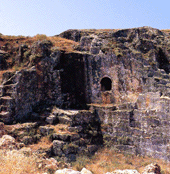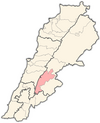Kamid el-Loz
Kamed Al Lawz/Kamid el-Loz
كامد اللوز | |
|---|---|
City | |
UTC+3 (EEST) | |
| Dialing code | +961 |
| Site notes | |
|---|---|
| Condition | ruins |
| Public access | Yes |
Kamid el-Loz, also spelled Kamid al-Lawz, is located in West
History
In 1838,
Archaeology
Tell Kamid el-Loz was the site of major German archaeological excavations between 1963 and 1981. One of the most important sites in Lebanon where archaeologists found and recorded many spectacular buildings, which are very important to the history of the region.
Numerous urban structures such as defense systems, temples, palaces, private dwellings, workshops and cemeteries were uncovered. Archaeologists also found everyday objects such as pottery, as well as jewelry and other luxury items.
Cuneiform tablets
Probably the most important finds were documents written in
South of the village we find a
The archaeological site of Kamid Loz I is located 2 kilometres (1.2 mi) north-east of the village of Kamid el-Loz and 4.5 kilometres (2.8 mi) north-northeast of Joub Jannine. The site showed a direct transition from Paleolithic material which was mixed with flints from an aceramic, vigorous culture, little recorded in the archaeological record called the Qaraoun culture inhabiting the area at the start of the Neolithic Revolution. Heavy Neolithic flints from this culture collected here included scrapers, picks and axes along with a large amount of debris.[8][9]
See also
References
- ^ "The Monthly: issue 91" (PDF). Information International s.a.l. pp. 4, 7. Archived from the original (PDF) on 4 March 2016. Retrieved 8 December 2015.
- ^ Robinson and Smith, 1841, vol 3, 2nd appendix, p. 142
- ISSN 1724-1855
- ISBN 978-0-306-46158-3. Retrieved 2 May 2011.
- ISBN 978-0-7614-7877-5. Retrieved 1 May 2011.
- ^ Leila Badre (1980). Les figurines anthropomorphes en terre cuite à l'âge du Bronze en Syrie. P. Geuthner. Retrieved 1 May 2011.
- ISBN 978-0-931464-29-4. Retrieved 1 May 2011.
- ^ Moore, A.M.T. (1978). The Neolithic of the Levant. Oxford University, Unpublished Ph.D. Thesis. pp. 444–446.
- ^ L. Copeland; P. Wescombe (1966). Inventory of Stone-Age Sites in Lebanon: North, South and East-Central Lebanon. Impr. Catholique. Retrieved 29 August 2011.
Bibliography
Further reading
- Penner, Silvia, Kāmid el-Lōz 19. Die Keramik der Spätbronzezeit: Tempelanlagen T3 bis T1, Palastanlagen P5 bis P1/2, Königsgrab ("Schatzhaus") und "Königliche Werkstatt", Saarbrücker Beiträge zur Altertumskunde 63, Bonn: R. Habelt, 2006. OCLC 180962628, 2006.
- Huehnergard, John, “A Byblos Letter, Probably from Kamid el-Loz”, ZA 86, pp. 97–113, 1996.
- Lilyquist, Christine, “Objects Attributable to Kāmid el-Lōz and Comments on the Date of Objects in the ‘Schatzhaus’”, in Adler, W. (ed.), Kāmid el-Lōz 11 – Das ‘Schatzhaus’ im Palastbereich: Die Befunde des Königsgrabes, Saarbrücker Beiträge zur Altertumskunde 47, Bonn: Habelt, pp. 207–220, 1994.
- Lilyquist, Christine, “Stone Vessels at Kāmid el-Lōz, Lebanon: Egyptian, Egyptianizing or Non-Egyptian? A Question at Sites from the Sudan to Iraq to the Greek Mainland”, in Hachmann, R. (ed.), Kāmid el-Lōz 16 – ‘Schatzhaus’-Studien, Saarbrücker Beiträge zur Altertumskunde 59, Bonn: Habelt, pp. 133–73, 1996.
- Maurer, Alfred Werner., “Reise in den Orient zur Grabung Kamid el-Loz, Lebanon 1973”, Philologus Verlag Basel(ch)2006.
- Hachmann, Rolf., “Kāmid el-Lōz und die Amarna-Zeit oder vom Sinn und Unsinn der Kulturgeschichte und ihrer Erforschung” Saarbrücken 1972.
- Hachmann, Rolf, “Der Palast eines syrischen Kleinkönigs der späten Bronzezeit in Kāmid el-Lōz” in: D. Papenfuss u. V. M. Strocka (Hrsg.): Palast und Hütte. Beiträge zum Bauen und Wohnen im Altertum von Archäologen, Vor- und Frühgeschichtlern. Mainz: pp. 21–41, 1982.
- Hachmann, Rolf (Hrsg.), “Frühe Phöniker im Libanon – 20 Jahre Ausgrabung in Kāmid el-Lōz” Institut für Vor- und Frühgeschichte und Vorderasiatische Archäologie der Universität des Saarlandes, Saarbrücken 1983, ISBN 3-8053-0772-1(Museumsausgabe).
External links
- Kamed El Laouz, Localiban
- Kāmid el-Lōz. Institut für Vor- und Frühgeschichte und Vorderasiatische Archäologie Informationen zu den Grabungen 1963–1981.
- inclut des liens vers les rapports annuels d'excavation de Kamid el-Loz (allemand)



